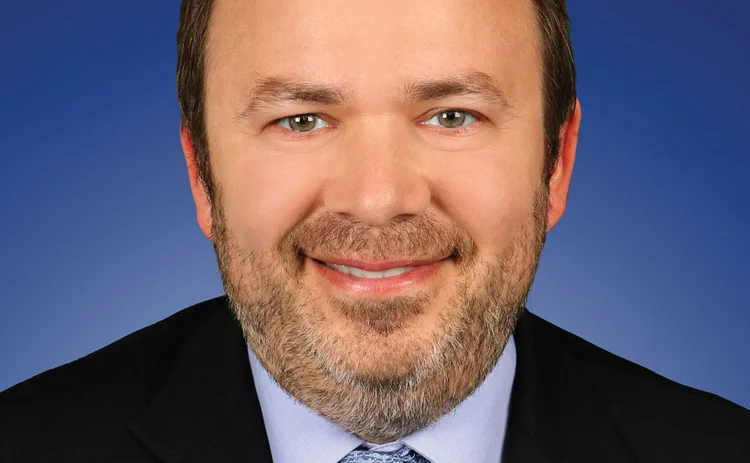
Hedge fund of the year: Saba Capital Management
Risk Awards 2021: credit specialist proved its worth in the Covid crisis

In late 2019, Boaz Weinstein was seeing mispricings in credit markets on a scale he’d never seen before – the kind of twisted values that meant spreads on Sabre, a newfangled travel-tech company, were the same as for a solid credit like fast-food chain McDonald’s.
“In my career, I had never seen such a tight packing between double-Bs that you would want to short and single-As you’d want to go long,” he says.
By the end of the year and in the opening weeks of 2020, one of the main trades at Weinstein’s Saba Capital Management was to short a basket of riskier high-yield credits and go long a basket of quality names. “The market allowed you to do that basically for zero cost,” he says.
Even as late as February 21, when news was breaking of clusters of Covid cases in northern Italy, the closing spread on five-year Sabre credit default swaps (CDSs) was around 30 basis points. Today, the company’s CDS trades at around 350bp. McDonald’s remains at 25bp. And Saba was among the investing firms that profited most from the repricing.
Saba’s Capital Tail Fund, a vehicle designed to take advantage of market shocks, recorded gains of 99% in March. Its flagship Capital Master Fund advanced 33%. Amid the market uncertainty of 2020, Saba saw inflows of $1.7 billion.
Few others in the markets have that kind of story to tell. During the Covid tumult, equity markets traced their fastest crash on record, shedding more than a quarter of their value in four trading days. The US Treasury market seized up. Central banks were forced to inject $7.8 trillion in support to stop global financial markets sinking. Real yields for US investment grade corporate credit turned negative. Downgrades from investment grade to high-yield status broke records.
The last time market participants suffered such pain, Weinstein was among those feeling it. After becoming the youngest ever managing director at Deutsche Bank, he led the proprietary credit trading desk that famously suffered over a billion dollars in losses in the 2008 financial crisis.
In early 2020, by contrast, Weinstein’s Saba had accumulated positions that would see the firm prosper as others stumbled – long positions in safe investment grade companies, versus shorts in high-yield and leveraged investment grade credits. Saba had also bet that credit curves that were steeper in late 2019 than at any time in recent years would flatten.
As reports of the pandemic during January and February pointed to a gathering storm, Saba added $1 billion to its flattener trade and roughly $500 million to its short portfolio of lower quality CDS protection. Then, as markets crashed in March, sending the value of the firm’s portfolio through the ceiling, Weinstein saw a chance to lock in gains at higher levels via the bond-CDS basis trade. The opportunity was so great that Saba launched a new fund in just days to do so.
At the extremes
In late 2019 and at the start of 2020, investment grade and high-yield credit spreads were trading at historically tight levels, Weinstein says. “Most of the spread in the HY CDX index was contained in a few fallen angels blowing out in the investment grade index and nearly defaulted companies in the high-yield index. If you threw out the outliers, the averages were very tight.”
Investment grade companies such as AT&T, British American Tobacco, Disney, IBM and Verizon were trading at spreads little different from “more dicey” high-yield companies. On February 12, for example, the HY CDX index traded at a spread of just 280 basis points.
Banks buying CDSs on the high-quality companies they lent to, such as IBM, for its $34 billion acquisition of software company Red Hat in 2019, had driven up the cost of investment grade protection, Weinstein explains. And traders arbitraging the richness of the HY CDX index were buying protection on the index and selling protection on the 100 single names it contained, feeding markets a ready supply of cheap CDSs on high-yield companies.
Already in 2019, Saba had begun building short positions in businesses like Royal Caribbean and United Airlines. In past market downturns, travel and leisure companies had run into trouble, and Weinstein was sure the credit mispricing in those industries would at some point realign.
In my career, I had never seen such a tight packing between double-Bs that you would want to short and single-As you’d want to go long
Boaz Weinstein, Saba Capital Management
Weinstein had seen another mispricing, too, in the steepness of the credit curve. The CDX IG 5-year CDS was trading at a spread of around 50bp compared with the CDX IG 10-year at around 100bp, the greatest difference of the past five years. Saba’s trade was to buy two units of five-year protection at 50 and sell one unit of 10-year protection at 100.
“The curve flattening was something that was fairly predictable,” Weinstein says. “Entering the trade, you were entering at a historically steep level. It felt really like a mispricing to me because there’s only a certain amount of steepness that you could reasonably expect.”
In January, reports of human-to-human virus transmission started to emerge from China, but markets remained steady. The S&P 500 marked a record high on February 19.
Saba, meanwhile, was adding to its positions. In Sabre, the fund held more than half the net open CDS interest of about $180 million. “We had this long/short portfolio of maybe two dozen names on each side,” Weinstein says. “We were able to put on tail protection that didn’t have a cost to it.” That’s not to say the risk was zero, he points out. “There was no negative carry, no bleed for owning that protection. But there’s always the risk that a stretched relationship gets more stretched.” In its curve flattener trades Saba sized up positions also.
Turning point
When markets turned after March 9, Saba’s long portfolio spreads widened by about 200% but the short portfolio blew out twice as much. Between February 19 and March 20, five-year investment grade index CDSs moved 90bp, out to 140, while the 10-year moved only 50bp, to 150. “The credit market was super resistant to Covid news, until it wasn’t,” Weinstein says.
By the end of March, Weinstein was looking to lock in the firm’s gains, turning to bond-basis trades to do so. These had played a small role in Saba’s portfolio before 2020 as an additional means of funding its credit plays. The firm routinely scanned 18,000 bonds and the 800 different CDS contracts on the lookout for divergences in pricing.
Coming into 2020 the bond-basis on average was about 100bp, Weinstein explains. During March, though, cash bonds experienced mass selling, driving prices down. And that allowed Saba to establish basis packages – going long cash bonds and buying CDS protection on the same names – at around 500 to 1,000bp. “We added to negative basis trades with both arms.”
To make the most of the trade, Saba began marketing a new fund – the Basis Opportunities Fund – in early April and launched it on May 7, 2020, with $230 million in AUM.
“When the bond selloff happened, firms like Saba Capital and Pershing Square owned tens of billions of notional CDS,” Weinstein says. “When spreads blew out, in some cases we were deciding whether to sell our CDS for 500bps or to buy bonds at 900. In that moment, a bunch of our CDS positions became interesting to hedge with basis.”
Weinstein pitches Saba as a provider of cheap insurance against market corrections. The firm fulfilled its mandate in 2020. Looking forward, Weinstein sees plenty of opportunities to buy cheap protection in future. “I’ve been trading credit against equity and credit against equity options for 20 years,” he says. “There are some really wild divergences right now.”
Only users who have a paid subscription or are part of a corporate subscription are able to print or copy content.
To access these options, along with all other subscription benefits, please contact info@risk.net or view our subscription options here: http://subscriptions.risk.net/subscribe
You are currently unable to print this content. Please contact info@risk.net to find out more.
You are currently unable to copy this content. Please contact info@risk.net to find out more.
Copyright Infopro Digital Limited. All rights reserved.
As outlined in our terms and conditions, https://www.infopro-digital.com/terms-and-conditions/subscriptions/ (point 2.4), printing is limited to a single copy.
If you would like to purchase additional rights please email info@risk.net
Copyright Infopro Digital Limited. All rights reserved.
You may share this content using our article tools. As outlined in our terms and conditions, https://www.infopro-digital.com/terms-and-conditions/subscriptions/ (clause 2.4), an Authorised User may only make one copy of the materials for their own personal use. You must also comply with the restrictions in clause 2.5.
If you would like to purchase additional rights please email info@risk.net
More on Awards
Environmental products house of the year: ENGIE
ENGIE is driving change in energy transition, with a strong focus on renewable energy and the liberalisation of power markets in Apac, which presents significant long-term growth opportunities. In recognition of its efforts, ENGIE GEMS has been named…
Natural gas/LNG house of the year: ENGIE
ENGIE continues to expand its services to better serve firms in Apac dealing with the challenges of energy risk management and supply
FRTB management solution of the year: Bloomberg
Amid the diverging timeframes and complex requirements of FRTB, Bloomberg offers a consistent, comprehensive and customisable solution for Apac banks preparing for implementation
Newcomer of the year: Topaz Technology
Jon Fox and former colleagues formed Topaz Technology in 2015. Having seen many different systems and, in some cases, written and built a few themselves, there was always something missing, leading them to build a system that unifies risk reporting and…
Technology vendor of the year: Murex
As a technology vendor, Murex places adaptability front and centre of everything it does, constantly enriching its MX.3 platform to ensure institutions can respond to new market opportunities as soon as they spot them
Currency derivatives house of the year: Deutsche Bank
Asia Risk Awards 2024
Interest rate derivatives house of the year: Standard Chartered Bank
Asia Risk Awards 2024
Derivatives house of the year, Taiwan: CTBC Bank
Asia Risk Awards 2024







